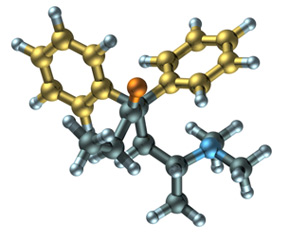
Toxicology Litigation Support
Methadone

Methadone is an opioid thought to act by decreasing release of neurotransmitters in the brain resulting in respiratory suppression and, in some cases, death. Several studies have described naive patients who expired shortly after entering methadone maintenance programs which did not adequately assess tolerance prior to initiation of methadone therapy. Naive users require more time to clear methadone from their bodies placing them at increased risk of overdosing. Liver or kidney dysfunction can greatly prolong methadone clearance resulting in increased risk of adverse effects. Doses of 50 mg or less of methadone have proven fatal to non-tolerant adults. The half-life of elimination of methadone is thought to be about 15 hours, but it could be as long as 55 hours in some cases. Autopsies have shown average blood concentrations of 0.28 mg/L with a range of 0.06 to 3.1 mg/L in 59 victims versus 0.11 mg/L in methadone maintenance patients.
Methadone Fatalities
Blood Concentrations
- mean 0.28 mg/L (range 0.06 - 3.1) in 59 victims of methadone overdose
- mean 1.0 mg/L (range 0.4 to 1.8 mg/L) based on 10 fatalities
- mean 0.584 mg/L (range 0.084 - 2.7 mg/L) based on 55 cases
- mean 0.957 mg/L based on 17 fatalities from methadone
- mean 0.73 mg/L based on 10 fatalities from methadone
- case reports: 0.03 mg/L, 0.5 mg/L, 0.9 mg/L in methadone fatalities
- in 22 cases range from 0.06 to 0.5 mg/L in methadone fatalities
- mean 0.75 mg/L in five death cases caused by methadone
- mean 0.43 mg/kg blood conc in 59 dead addicts
- mean 0.47 mg/kg blood conc in 11 dead addicts
- mean 0.7 mg/L based on six methadone fatalities
Liver Concentrations
- mean 3.8 mg/kg (range 1.8 - 7.5 mg/kg) in 59 victims of methadone overdose
- range 7.6 to 11 mg/kg based on 10 fatalities from methadone
- mean 2.15 mg/kg (range 0.4 - 49.5 mg/kg) in 11 death cases from methadone
- mean 5.1 mg/kg (as low as 1 mg/kg) in 5 death cases related to methadone
- mean 2.4 mg/kg in 71 dead addicts related to methadone
- mean 3.6 mg/kg (range 0.7 to 9.05 mg/kg) in six methadone fatalities
Dr. Parent has participated in several methadone death cases and has developed a sizeable list of methadone-related scientific publications. Selected references are provided below.
Report Exmple
Fatal cases of methadone poisoning have shown average blood concentrations of 1 mg/L [1 µg/ml] with a range from 0.4 to 1.8 mg/L. Concentrations of methadone found in post-mortem liver, the primary site for methadone metabolism, have been reported as a mean of 3.8 mg/kg [µg/g] with a range of 1.8 to 7.5 mg/kg.4
Selected References
Ali, R. L. and Quigley, A. J., Accidental drug toxicity associated with methadone maintenance treatment. Medical Journal of Australia, 170(3), 100-101 (1999).
Caplehorn, J. R. and Drummer, O. H., Mortality associated with New South Wales methadone programs in 1994: lives lost and saved. Medical Journal of Australia, 170(3), 104-109 (1999).
Drummer, O. H., Opeskin, K., Syrjanen, M. and Cordner, S. M., Methadone toxicity causing death in ten subjects starting on a methadone maintenance program. American Journal of Forensic Medicine and Pathology, 13(4), 346-350 (1992).
Drummer, O. H., Syrjanen, M., Opeskin, K. and Cordner, S., Deaths of heroin addicts starting on a methadone maintenance programme. Lancet, 335(8681), 108 (1990).
Garriott, J. C., Sturner, W. Q. and Mason, M. F., Toxicologic findings in six fatalities involving methadone. Clinical Toxicology, 6(2), 163-173 (1973).
Greene, M. H., Luke, J. L. and DuPont, R. L., Opiate overdose deaths in the District of Columbia. II. Methadone-related fatalities. Journal of Forensic Science, 19(3), 575-584 (1974).
Karch, S. B. and Stephens, B. G., Toxicology and pathology of deaths related to methadone: retrospective review. Western Journal of Medicine, 172(1), 11-14 (2000).
Milroy, C. M. and Forrest, A. R. W., Methadone deaths: a toxicological analysis. Journal of Clinical Pathology, 53, 277-281 (2000).
Segal, R. J. and Catherman, R. L., Methadone--a cause of death. Journal of Forensic Science, 19(1), 64-71 (1974).
Vormfelde, S. V. and Poser, W., Mortality associated with New South Wales methadone programs. Medical Journal of Australia, 171(8), 442-443 (1999).
Wu, C. H. and Henry, J. A., Deaths of heroin addicts starting on methadone maintenance. Lancet, 335(8686), 424 (1990).

Causation Reports
- Benzene
- Carbon Monoxide - NEW
- Chlorine Letter Report - NEW
- Ephedrine
- Hexavalent Chromium - NEW
- Lead - NEW
- Lindane
- Manganese and Welding Fumes
- Marijuana Letter Report - NEW
- Methadone
- Methotrexate Letter Report - NEW
- Ozone - NEW
- Sulfur Dioxide - NEW
- Vinyl Chloride
- Vioxx
Toxicology Notes and Literature
- Alcohol Notes
- Arsenic References
- Cocaine References
- Carbon Monoxide Notes
- Creosote Notes
- Diesel Fumes
- Dramshop Blurb
- Marijuana References
- Ozone Blurb
Toxicology Litigation Support
- Class Action & Toxic Tort
- Expert Witness & Trial Support
- Insurance Defense & Workers Compensation
- Chinese Dry Wall & Slide Presentation
- Causation Slide Presentation
- Structuring an Expert Report Slide Presentation
- 1,4 - Dioxane
- Alcohol
- Arsenic
- Baycol
- Cocaine
- Creosote
- Diesel Fumes
- Fentanyl
- Formaldehyde
- Marijuana
- Oil Spills
- PCBs and Dioxins
- Perchloroethylene, Trichlorothylene and Chlorinated Hydrocarbons
- Phenylpropanolamine (PPA)
- Zyprexa

